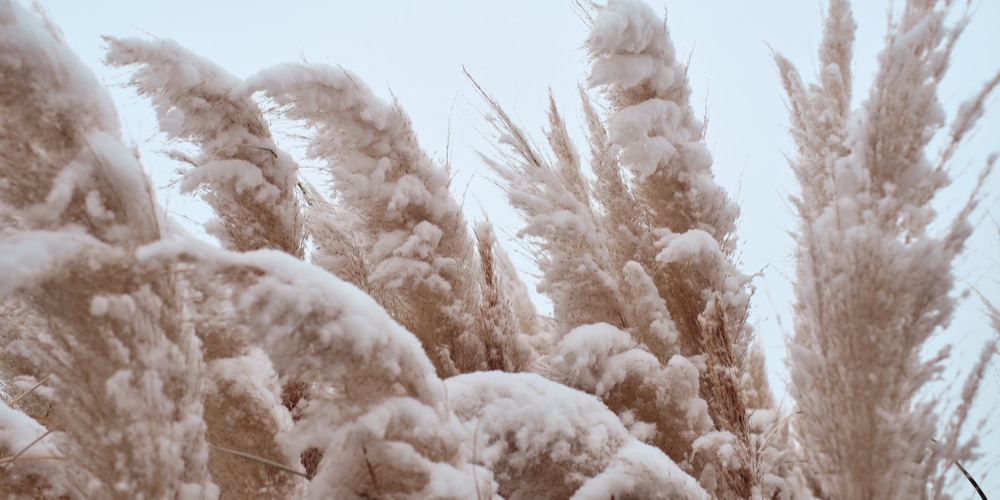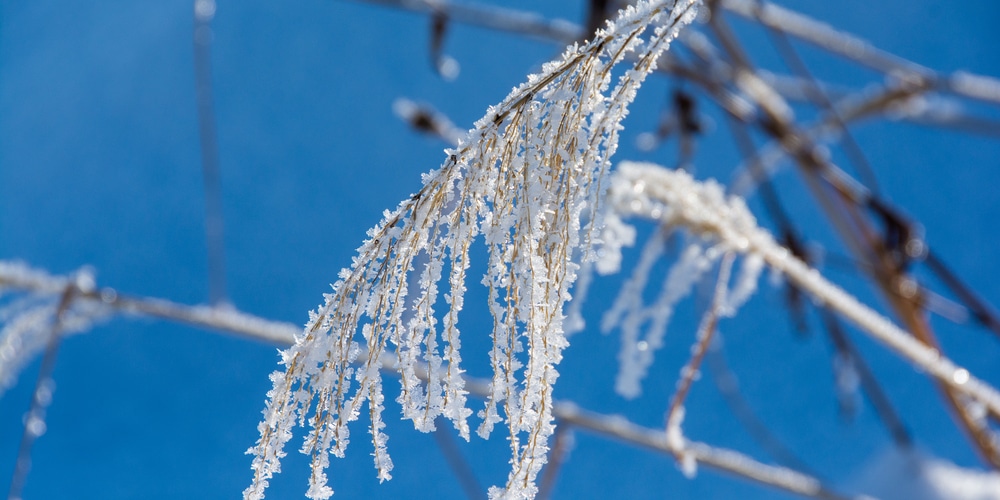Pampas grass is a beautiful ornamental grass that grows in large tufts. The blades are long and slender, and they waft gracefully in the breeze. The flowers are large, fluffy, and showy, ranging in color from white to pink to purple.
Thanks to its showy flowers and attractive leaves, pampas grass is often used as an ornamental plant in gardens and landscapes. It gives a bold statement and can create a striking focal point. Because they’re easy to grow and care for, pampas grasses are also popular in public parks and other public areas.
There’s no denying that pampas grass is a showstopper. But the question is, can it survive the cold winters? What do you do with your grass when winter comes?
Overwintering Pampas Grass

Pampas grass is a beautiful, dramatic plant that adds an exotic touch to any garden. In winter, the leaves of pampas grass turn a rich gold hue, providing a striking contrast to the barren landscape.
These hardy plants can withstand temperatures as low as -15 degrees Fahrenheit, perfect for gardens in colder climates. They thrive in cooler hardiness zones.
There are different methods you can use to overwinter pampas grass, but here are some of the most common things you can do:
Cut Back Old Foliage
Winter is a time of dormancy for most plants when growth slows and leaves fall. However, some plants, such as pampas grass, remain evergreen and continue to grow throughout the winter months.
If you live in a cold climate, you’ll need to take special care of your pampas grass to ensure that it survives the winter. One of the most important steps is to cut back old foliage. This will help prevent the plant from becoming too top-heavy and toppling over in heavy snow.
Cutting back pampas grass is most ideal during the last few days of fall. Aside from cutting back old foliage, you may also want to get rid of stalks longer than 12 inches. This will help keep the plant neat and tidy and prevent it from becoming too top-heavy.
Mulch Over the Plant’s Base
To protect its tall plumes of silvery-white flowers from heavy snow and cold winters, you’ll need to mulch over the plant’s base. Mulching is one of the oldest methods used to protect plants from the cold. It involves placing a layer of material, such as straw, over the ground around the plant. Doing so helps to insulate the roots and prevent them from freezing.
Water Deeply Before the First Frost
Another step to preparing your pampas grass for the winter is to remember to water it deeply before the first frost. This will help keep the roots from drying out and prevent the plant from dying.
Cover the Plant with a Cloche
A cloche is a bell-shaped glass or plastic cover that helps trap heat and humidity around the plant. To use a cloche, simply place it over the plant and secure it in place with stakes or sandbags. The cloche will create a miniature greenhouse effect, allowing the plant to stay warm and protected throughout the winter.
Just be sure to remove the cloche when the weather begins to warm up in spring, as pampas grass does not tolerate heat well.
Fertilize After Cutting
Usually, you’ll want to fertilize your pampas grass after cutting it back. This will give the plant the nutrients it needs to regrow in the spring. You can use any type of fertilizer, but it’s recommended to use 8-8-8 fertilizer or something similar.
Does Pampas Grass Grow Back After Cutting?
Many are afraid to cut back their pampas grass for fear that it will not grow back. However, this is not the case. Pampas grass is a very resilient plant and will quickly bounce back after being cut.
On the contrary, not cutting back the plant can lead to problems, such as the plant becoming too top-heavy and toppling over.
In fact, it’s recommended to do this every year, as soon as winter. Getting rid of the old foliage will encourage new growth in the spring. When cutting back pampas grass, remember to wear leather gloves, as the leaves are sharp and can cut skin.
Pampas grass in winter: Final Thoughts
Pampas grass is a head-turner in any garden, and it’s easy to see why. With its tall plumes of silvery-white flowers, it’s a plant that is sure to get noticed. And while it’s often associated with warm climates, pampas grass is actually quite hardy and can withstand cold winters.
Following the tips above will help you overwinter your pampas grass and keep it looking its best. Pruning is one of the most important steps, so don’t forget to give it a little trim right after the first frost. And be sure to mulch over the plant’s base and cover it with a cloche for extra protection from the cold.
Related Article: When To Plant Pampas Grass?
